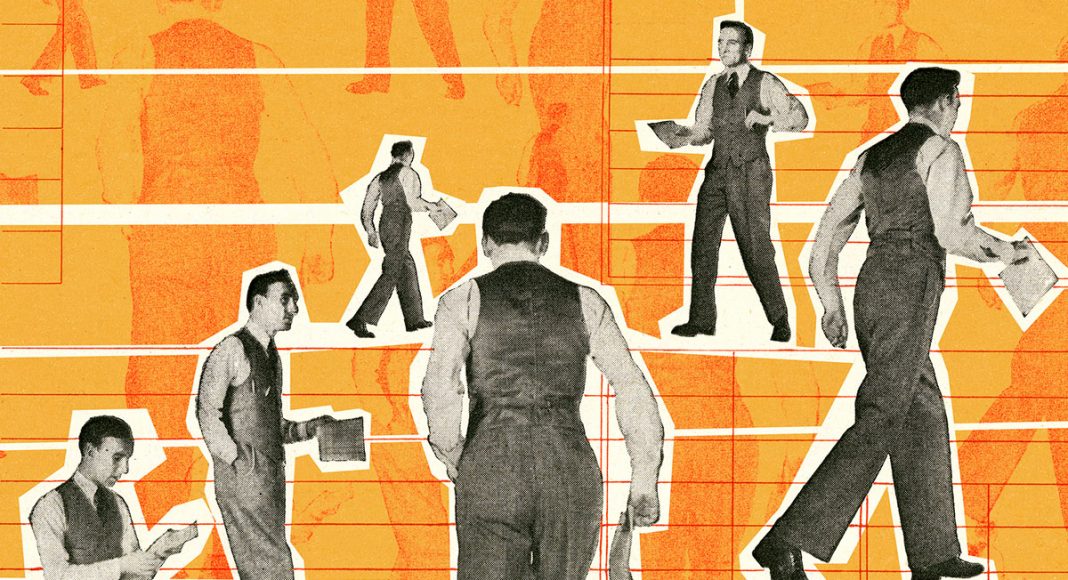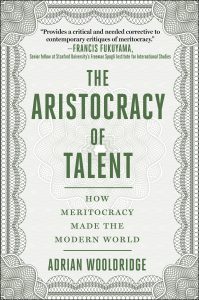In the following excerpt from his new book, The Aristocracy of Talent: How Meritocracy Made the Modern World, Adrian Wooldridge traces “how universities became more important in controlling entry into the professional life”.
American business played a significant part in nurturing the meritocratic spirit. Giant businesses such as the railroads required specialized middle-managers to keep the trains running on time, and great universities such as the University of Pennsylvania and Harvard established business schools to produce them. The advance of the business meritocracy was nevertheless patchy before the Second World War. Much of the business world remained resolutely anti-intellectual. Sinclair Lewis’s Babbitt (1922) is a merciless portrait of American business at the beginning of the roaring twenties. George F. Babbitt, the eponymous hero, is the very model of a solid citizen: an estate agent by profession, “nimble in the calling of selling houses for more than people could afford to pay”, and a conformist by temperament, proudly devoid of original ideas or intellectual curiosity. He surrounds himself with clever gadgets like alarm clocks and electric toasters that symbolize the power of technology. He wears a booster’s club button to signify his loyalty to his local town, Zenith, and his willingness to praise it on all occasions, however overwhelming the evidence to the contrary. His friends, such as Joseph K. Pumphrey, owner of the Riteway Business College and “instructor in Public Speaking, Business English, Scenario Writing, and Commercial Law”, are all exactly like him, boosters and conformists. The book gave the English language a word, “Babbitt”—meaning a “person and especially a business or professional man who conforms unthinkingly to prevailing middle-class standards”—and a George Gershwin song, “The Babbitt and the Bromide“.
Babbitt was typical of many American businessmen in his contempt for “book learning” and his admiration for “common sense”. In 1924 an anonymous businessman wrote an article in an American magazine under the title “Why I Never Hire Brilliant Men”. Brilliance is invariably associated with intemperance and irresponsibility; it’s far safer to rely on “hard-headed” and “hard-muscled” types. The great entrepreneurs were usually self-made men who had succeeded without the benefit of higher learning or careful breeding (in 1900, fewer than one in five business leaders had completed a university degree). Henry Ford combined a genius for car-making with buffoonish, and frequently contemptible, views on foreign policy and politics. H. L. Mencken thought that the average American businessman belonged to the species “Boobus americanus”.
Business schools started life as crosses between trade schools and rotary clubs: students picked up a smattering of trade craft and a collection of friends for life but didn’t engage with the big ideas that were transforming economics. Consultancies focused on forging lasting relations with big companies rather than selling ideas. Marvin Bower, McKinsey’s guiding spirit, was so determined that McKinsey men should look the part that he insisted, until 1963, that they wore a hat when they went out in public. Many company men preferred to acquire their knowledge on the job rather than in universities, with the most successful companies, such as IBM, General Electric and Kodak, offering lifetime employment and sending promising company men (and a few women) to their own internal training schools.
The great American sociologists of the 1950s portrayed businessmen as anti-intellectual conformists. In Organization Man (1956), William Whyte described the typical businessman as an affable type who puts fitting in above everything else—pleasant, easy to get along with, but hardly rocket scientists. He entitled one chapter “The Fight against Genius”. In The Pyramid Climbers, Vance Packard described successful executives as “polished, cool, handsome, adaptable, highly energized, soft-spoken, over-integrated, non-oddball power players. Often they also have demonstrated during their rise a conspicuous ability to keep their heads down and their noses clean.” The command centers of the business world were rotary clubs and golf clubs rather than faculty lounges and laboratories.
The first sign that the relationship between business and trained intelligence was changing was provided by the arrival of the whizz-kids after the Second World War. The whizz-kids were a group of highly educated Air Force officers, including Robert McNamara and Tex Thornton, who persuaded Henry Ford II to give them all a job at the end of the war. They then succeeded in rescuing the ailing company from disaster not by producing better products—they didn’t really know that much about motor cars—but by producing better companies, largely by imposing tight financial and managerial controls. They then applied the same techniques to a range of other companies and institutions outside the automobile sector: Thornton created Litton Industries, America’s first major conglomerate, and McNamara moved to the Pentagon, where he tried to win the Vietnam War by escalating kill rates, and then the World Bank.
The two institutions that cemented the relationship between business and trained intelligence were business schools and consultancies. In 1966, the Carnegie and Ford foundations combined to publish a searing report that argued that business schools needed to justify their place in universities by producing more original research. Thereafter, the schools embraced both the publish-or-perish mentality and the intellectual star system that prevailed in the rest of academia. Business schools hatched professors who were notable not just for their knowledge of particular businesses but for their ability to produce intellectual models: strategists such as Michael Porter and finance theorists such as Michael Jensen, who tried to bring the rigor of economics to the study of business. They also mass-produced MBAs who had little time for the post-war business establishment, with its clubby culture and three-Martini lunches, and who wanted instead to force American business to sit up and shape up—by pursuing shareholder value if they were disciples of Jensen or by examining the operation of the “five forces” if they were Porterites.
The same cult of “smarts” gripped management consultancies. Bruce Henderson, the founder of the Boston Consulting Group (BCG), believed that the company’s only chance of challenging McKinsey lay in out-thinking it rather than out-networking it. To that end, he produced a series of elegant intellectual models such as the “experience curve”, which taught companies that they could reduce their costs as they expanded their market share, thanks to the accumulation of knowhow, and the “growth share matrix”, which encouraged companies to view themselves not as an undifferentiated whole but as a portfolio of businesses that make different contributions to the bottom line (“cash cows” vs “dogs”, for example). McKinsey hit back by producing business gurus of its own such as Tom Peters and Robert Waterman, the authors of In Search of Excellence (1982), and Richard Pascale, the author of The Art of Japanese Management (1981).
A good example of the growing influence of business theory is provided by the Romney dynasty. George Romney, who didn’t graduate from university, worked in the manufacturing sector for twenty-three years, running the American Motors Corporation for eight of them and becoming “a folk hero of the American auto industry”. Mitt Romney graduated in the top 5 percent in his class at Harvard Business School before joining three IQ-obsessed consultancies, first BCG in 1975, then Bain and Company two years later and, finally, as CEO, Bain Capital, which married strategic consultancy with the shareholder-value revolution by investing money in the firms it advised. Under Romney’s direction Bain Capital “re-engineered” more than 150 companies in a bewildering variety of industries and made the future Republican presidential candidate and US senator an estimated fortune of $200 million.
The new meritocrats thus transformed everything that they touched in post-war society: schools became avenues of mobility, universities became research institutions-cum-professional training schools; business became more preoccupied with the brainpower of its employees. All this inevitably provoked a backlash—first from the left and then from the right—as students baulked at relentless competition and employees wearied of being messed around by corporate whizz-kids.
Excerpted from Aristocracy of Talent: How Meritocracy Made the Modern World by Adrian Wooldridge, published by Skyhorse Publishing. Copyright © 2021 by Adrian Wooldridge. Used by permission. All rights reserved.







